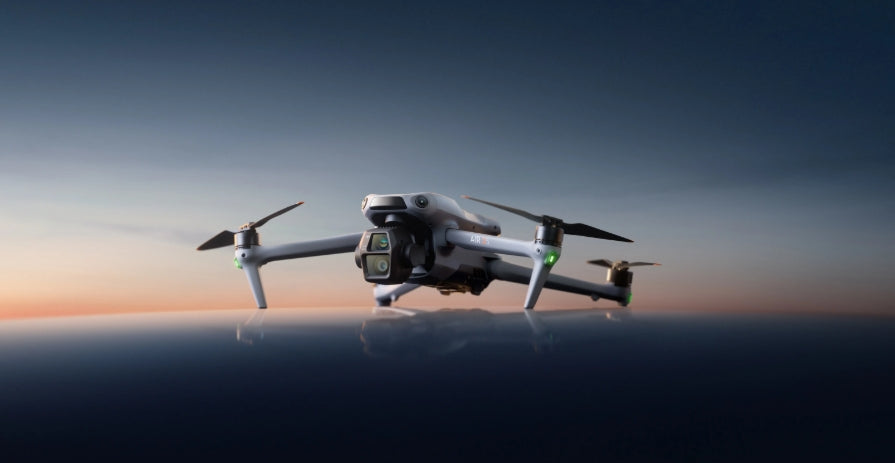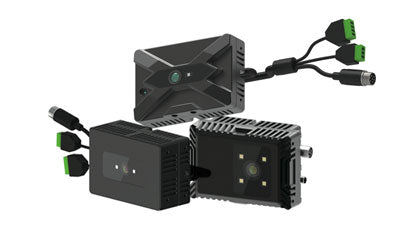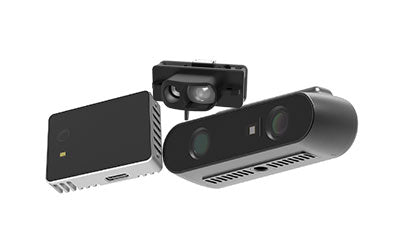TOF Integration in Low-Altitude :Key Tech for Drone Obstacle Avoidance

As the low-altitude economy heats up under the dual drivers of policy and technology, the drone industry is experiencing unprecedented growth. From logistics and city management to agricultural inspection and emergency response, drones are evolving from 'toys' to intelligent aerial platforms with industrial applications. In this transformation, the 3D TOF (Time-of-Flight) camera is playing an increasingly vital role as a core perception module.
Drone Industry Expansion Amid the Low-Altitude Economy Boom
The 'low-altitude economy' refers to an emerging economic model based on airspace below 3,000 meters. In recent years, with policy support, flight control system optimization, and battery technology innovation, drones have been widely adopted in applications like power line inspection, forest fire prevention, logistics, crop protection, and urban 3D modeling. In China alone, the civil drone market surpassed 100 billion yuan in 2024 and continues to grow rapidly.
However, low-altitude airspace is complex and obstacle-dense. Traditional flight based on GPS or IMU (Inertial Navigation Unit) falls short in providing high-precision obstacle avoidance and safe landings in such environments, demanding more advanced perception systems for drones.
TOF Modules: Enabling Intelligent Navigation, Obstacle Avoidance, and Hovering
What is a 3D ToF camera?
A Time-of-Flight (TOF) camera is a 3D sensing device that calculates depth by measuring the time it takes for emitted infrared light to bounce back from a surface. This technology creates high-precision depth maps and 3D spatial data. Compared to stereo vision or structured light systems, TOF cameras offer stronger robustness and reliability in challenging environments such as low light, strong sunlight, fog, dust, or rain, making them ideal for outdoor drone operations.
TOF modules have become crucial components in drone flight control systems in several key areas:
Smart Obstacle Avoidance: Real-Time Recognition and Evasive Maneuvers
TOF cameras provide real-time 3D depth information, enabling drones to accurately detect obstacle distance, shape, and location—even in low-texture or monotone backgrounds—allowing dynamic path adjustments with millimeter-level accuracy. This greatly enhances autonomous flight in complex environments like forests, power towers, and urban areas.
Stable Hovering: Depth-Aided Positioning When GPS Fails
With TOF-generated depth data, drones can achieve high-precision hovering in GPS-denied environments such as tunnels, under bridges, or indoors. TOF also provides reliable vertical distance information for posture correction, improving wind resistance and hover stability—essential for tasks like mapping and fixed-point photography.
Precise Landing: Terrain Detection for Safe Descent
During takeoff and landing, TOF modules sense ground distance and terrain fluctuations in real time. They detect uneven surfaces, pits, or obstacles, preventing crashes or tilted landings due to visual misjudgment. This is particularly important in mountainous areas or on building rooftops.
3D Mapping & SLAM: Advanced Perception for Autonomous Navigation
By fusing TOF depth data with RGB images (RGB-D), and utilizing SLAM (Simultaneous Localization and Mapping) algorithms, drones can generate high-precision 3D maps. This enhances environmental understanding, path planning, and global navigation. Compared to visual-only SLAM, TOF-based SLAM performs better in dynamic and complex environments, making it suitable for inspection, surveillance, and search-and-rescue drones.
Modular Design: Lightweight, Compact, Low-Power, and Easy Integration
Modern TOF modules feature compact and lightweight designs, making them ideal for small and mid-sized drones. They often support multiple interfaces like USB, MIPI, or UART, enabling easy integration with flight control systems and edge computing platforms. Additionally, features like continuous or triggered sampling and ROI (Region of Interest) settings improve system flexibility.
As drone applications expand across fields like surveying, power inspection, agriculture, security, and logistics, flight safety and intelligence are becoming focal points of system upgrades. TOF modules, as core 3D sensing technologies, empower drones with a higher level of environmental awareness and decision-making. As TOF technology continues to improve in accuracy and cost-effectiveness, it is expected to become a standard for next-generation intelligent drone systems.
TOF vs. Ultrasonic & LiDAR: The Lightweight Advantage
Besides TOF, two other common sensing technologies in drones are ultrasonic sensors and LiDAR. However, TOF modules offer unique advantages:
| Technology | Accuracy | Size & Weight | Environmental Adaptability | Cost |
|---|---|---|---|---|
| Ultrasonic | Low to Medium | Lightweight | Prone to wind/noise | Very Low |
| LiDAR | Very High | Bulky | Affected by fog/dust | High |
| TOF 3D Camera | Medium to High | Ultra-light and compact | Strong interference resistance | Moderate |
Especially for mid- to low-cost drone platforms, TOF cameras combined with RGB-D vision offer a cost-effective solution with strong performance, making them ideal for lightweight obstacle avoidance.
Application Expansion Scenarios: Comprehensive Upgrades of Drone Applications in Logistics, Agriculture, and Urban Mapping
As Time-of-Flight (TOF) technology continues to mature and become more cost-effective, its real-world value across various drone application scenarios is rapidly increasing. This evolution not only empowers digital transformation in traditional industries but also drives drone systems toward greater intelligence and automation. Below are key application expansions of TOF in several major industries:
Smart Logistics and Delivery: Ensuring Last-Mile Flight Safety
In densely populated urban areas and remote regions, traditional ground-based delivery faces challenges such as traffic congestion and complex terrain. To overcome these issues, more logistics companies—like JD.com, SF Express, and Amazon—are deploying smart delivery drones equipped with TOF cameras to complete safe and efficient “last-mile” aerial deliveries.
With real-time depth sensing provided by TOF modules, delivery drones can accurately detect and avoid obstacles such as power lines, tree branches, and building edges, enabling precise maneuvering and safe landings. When integrated with AI algorithms, these systems can also analyze the structural layout of delivery points and pinpoint the exact drop zone for packages.
Agricultural Inspection and Smart Crop Protection: Accurate Sensing of Crop and Environmental Status
Agricultural drones equipped with TOF sensors can collect real-time data on crop height, canopy density, terrain variations, and obstacle locations during flight. When synchronized with RGB image processing, these drones can assess crop growth and optimize flight paths accordingly.
During field spraying operations, TOF modules help precisely control flying altitude and spraying coverage, reducing pesticide drift or under-application caused by altitude errors. This boosts operational accuracy and resource efficiency. TOF also proves valuable in agricultural inspections, especially in identifying greenhouse boundaries, irrigation ditches, and weed density.
Urban 3D Modeling and Mapping: Enabling Digital Upgrades in Spatial Information
Urban planning, infrastructure maintenance, and digital twin platforms increasingly rely on 3D Geographic Information Systems (GIS). Drones equipped with TOF modules and SLAM (Simultaneous Localization and Mapping) algorithms can capture spatial structure data and generate high-precision 3D point cloud maps. These maps help reconstruct urban buildings, roads, bridges, and parks in three dimensions.
Compared to traditional image-based or LiDAR-based methods, TOF offers significant advantages in data acquisition efficiency, integration flexibility, and cost control—especially suitable for small- to mid-sized projects and frequent data update requirements.
Emergency Rescue and Post-Disaster Assessment: Enhanced Navigation in Complex Environments
Natural disasters such as earthquakes, floods, and fires often result in unpredictable obstacles and structural damage. Traditional vision systems struggle under such conditions due to smoke, dust, and varying light levels. However, TOF modules, which are less affected by ambient light interference, provide stable and reliable depth data even in harsh conditions.
Rescue drones equipped with TOF can rapidly assess collapsed structures, obstacle distribution, and traversable paths, assisting command centers in planning rescue operations or guiding personnel and robots into targeted areas. TOF also enables dynamic obstacle avoidance and indoor navigation, extending its value in emergency scenarios.
AI Integration: Building Fully Autonomous and Intelligent Flight Systems
Some advanced 3D TOF cameras now feature built-in AI recognition and edge computing capabilities. With integrated functions like human detection, object tracking, gesture recognition, and obstacle classification, these modules can process data in real time and respond accordingly.
Combined with deep learning models, TOF modules enable advanced functions such as autonomous path planning, dynamic obstacle avoidance, and target following. These systems are widely used in intelligent security patrols, industrial park monitoring, and forest fire early warning, significantly enhancing drone autonomy and mission performance.
TOF technology provides drones with powerful environmental perception capabilities and is a foundational element for achieving autonomous flight, intelligent decision-making, and complex task execution. From logistics and agriculture to urban mapping and emergency rescue, TOF is propelling drone applications toward higher precision, greater safety, and deeper intelligence. As TOF module performance continues to advance and algorithms improve, its application boundaries will keep expanding—establishing TOF as a vital component in drone sensing systems.
Technical Challenges and Development of TOF Modules for Lightweight UAV Platforms
Despite the promising potential of TOF in drone-based perception and intelligent flight, adapting TOF to lightweight and compact drone platforms presents several technical challenges. Collaboration across industries is essential to strike the optimal balance between performance, size, and power consumption.
1. Technical Challenges
a. Enhanced Anti-Interference Capability
Outdoor flying environments are highly dynamic. TOF sensors must contend with strong sunlight, rain, fog, and dust—all of which introduce optical noise and multipath reflection interference. Harsh lighting conditions can weaken signal reception, reducing accuracy and stability.
To improve anti-interference, advancements are needed in light source wavelength selection, adjustable emission power, and receiver-side filtering. Additionally, more sophisticated signal demodulation and noise reduction algorithms must be developed to ensure accurate depth output even in extreme weather or lighting conditions.
b. Improved Data Processing Efficiency
TOF cameras produce large volumes of 3D point cloud and depth image data that must be processed in real time—especially for tasks like dynamic obstacle avoidance, path planning, and SLAM. Lightweight drone platforms are constrained by payload and battery life, limiting the onboard computing power.
Thus, TOF modules must be paired with lightweight edge computing chips to perform efficient data preprocessing, compression, and intelligent analysis—while maintaining low-latency output for real-time flight control.
c. Power Consumption and Thermal Management
Small drones have limited power and endurance. TOF modules, which rely on laser emitters and image sensors running continuously, face challenges in power consumption and heat dissipation. Designing low-power driver circuits and efficient cooling structures, along with dynamic power management, is critical for extending flight time and maintaining performance.
Furthermore, optimizing hardware-software coordination to reduce redundant computation and increase energy efficiency will be key to enhancing battery life.
d. Coordinated Algorithm Development
TOF depth data alone cannot meet all navigation demands in complex environments. To build intelligent flight systems, TOF data must be integrated with visual SLAM, AI object recognition, path planning, and environmental understanding algorithms.
Algorithms should be developed with TOF-specific features in mind—such as noise models, resolution limits, and field-of-view (FoV)—to enable robust and adaptive multi-sensor fusion for tasks like environmental modeling, dynamic avoidance, and intelligent decision-making.
2. Industry Trends and Future Directions
Currently, numerous domestic and international TOF module manufacturers are launching compact, high-performance TOF depth cameras tailored for drone applications. For instance, Benewake and other DTOF module makers have developed miniaturized TOF cameras capable of centimeter-level accuracy, low-latency output, and compatibility with industrial-standard Modbus 485 interfaces, making them easy to integrate with mainstream flight control systems like Pixhawk.
Key future development directions include:
-
Multi-Sensor Fusion: TOF modules will be increasingly combined with LiDAR, thermal imaging, IMUs, and more to enhance perception accuracy and reliability, especially in complex terrains and low-visibility conditions.
-
Intelligent Edge Computing Integration: TOF modules embedded with AI chips and deep learning models will enable real-time object recognition, dynamic path planning, and semantic understanding—paving the way for integrated “sense-decide-act” autonomous flight systems.
-
Modular and Customizable Design: TOF sensors will become highly modular and configurable to suit various drone sizes and types, supporting multiple interface protocols and power options for diverse needs—from consumer drones to industrial-grade UAVs.
-
Low Power and High Reliability: Advances in materials, integrated circuit design, and thermal solutions will continue reducing TOF module power consumption while improving stability and operational lifespan—ensuring long-duration, reliable flight.
Conclusion
As drones become increasingly central to the emerging low-altitude economy, lightweight and intelligent obstacle avoidance and ranging systems are fundamental to safe flight operations. The 3D TOF camera, with its high precision, low latency, and ease of integration, is quickly becoming the new standard, replacing traditional ultrasonic sensors.
In 2024, with ongoing innovation in TOF modules and breakthroughs in semiconductor technology, this integration will unlock new possibilities for future intelligent aerial robot systems.
Synexens 3D Of RGBD ToF Depth Sensor_CS30
Our professional technical team specializing in 3D camera ranging is ready to assist you at any time. Whether you encounter any issues with your TOF camera after purchase or need clarification on TOF technology, feel free to contact us anytime. We are committed to providing high-quality technical after-sales service and user experience, ensuring your peace of mind in both shopping and using our products.






